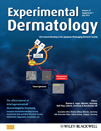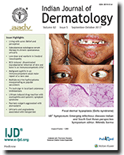
Dermatologica Sinica
Scope & Guideline
Unlocking New Insights in Dermatological Science
Introduction
Aims and Scopes
- Dermatopathology and Skin Cancer Research:
The journal frequently publishes studies on the diagnosis, treatment, and epidemiology of various skin cancers, including basal cell carcinoma and squamous cell carcinoma, reflecting a robust interest in oncological dermatology. - Innovative Treatment Modalities:
There is a consistent emphasis on new treatment approaches, particularly the use of biologics and novel therapies for conditions like psoriasis, pemphigoid diseases, and alopecia areata, showcasing the journal's commitment to clinical advancements. - Epidemiological Studies:
The journal includes numerous epidemiological studies that assess the prevalence, risk factors, and outcomes associated with dermatological conditions in specific populations, adding valuable insights into public health aspects of dermatology. - Clinical Case Reports:
A significant portion of the journal is dedicated to unique and rare case reports, which provide critical insights into unusual dermatological presentations and their management, contributing to the collective knowledge of dermatology. - Interdisciplinary Approaches:
Research often explores the intersection of dermatology with other medical fields, such as immunology and infectious diseases, indicating an integrative approach to understanding skin disorders. - Patient-Centric Research:
Studies focusing on patient experiences, treatment adherence, and quality of life in dermatological conditions are prevalent, highlighting the journal's commitment to patient-centered care.
Trending and Emerging
- Biologics and Targeted Therapies:
There is a marked increase in research focusing on biologics and targeted treatments for chronic skin conditions, such as psoriasis and pemphigus, highlighting the ongoing evolution of therapeutic options available to dermatologists. - Artificial Intelligence in Dermatology:
The rising trend of integrating artificial intelligence into dermatological diagnosis and treatment planning is gaining traction, with studies exploring its potential to enhance clinical decision-making and improve patient outcomes. - Impact of COVID-19 on Dermatology:
Research examining the effects of COVID-19 on dermatological conditions, treatment responses, and vaccine-related skin reactions has surged, reflecting the pandemic's profound impact on healthcare practices. - Personalized Medicine and Pharmacogenomics:
Emerging interest in pharmacogenomic studies related to dermatological treatments indicates a shift towards personalized medicine, with a focus on tailoring therapies based on individual genetic profiles. - Mental Health and Dermatology:
Increasing recognition of the psychological impact of skin diseases has led to more studies addressing the intersection of dermatology and mental health, advocating for holistic patient care.
Declining or Waning
- Traditional Topical Treatments:
Research focusing solely on conventional topical treatments for common skin conditions, such as eczema and psoriasis, has seen a decline, possibly due to the increasing interest in systemic and biologic therapies. - Basic Science and Mechanistic Studies:
There appears to be a waning interest in purely basic science studies that do not directly translate into clinical applications, as the journal shifts towards more applied and clinically relevant research. - Rare Dermatoses:
Although case reports of rare skin conditions are still published, there is a noticeable decrease in the frequency of these reports, suggesting a potential shift towards more common and impactful dermatological issues. - Historical Reviews and Archives:
The publication of historical reviews or retrospective studies on older treatments and diseases has diminished, indicating a preference for current and forward-looking research. - Local or Regional Studies:
There seems to be a reduction in studies that focus solely on local or regional dermatological issues without broader implications, potentially due to a growing emphasis on global health perspectives.
Similar Journals

BRITISH JOURNAL OF DERMATOLOGY
Shaping the future of dermatology, one article at a time.The British Journal of Dermatology, published by Oxford University Press, stands as a premier platform for advancing the field of dermatological research and clinical practice since its inception in 1892. With a strong commitment to disseminating high-quality research, this esteemed journal is currently ranked in the Q1 category for both Dermatology and Miscellaneous Medicine in 2023, reflecting its influential position in the academic landscape. As the leading journal in its field, it enjoys a robust Scopus ranking of #1 out of 142 in dermatology, placing it in the 99th percentile globally. The journal covers a wide scope of subjects pertinent to dermatology, including clinical trials, treatment innovations, and epidemiological studies, making it an essential resource for researchers, healthcare professionals, and students alike. Although it is not an open-access publication, it ensures a broad reach through institutional subscriptions, fostering knowledge exchange across the global dermatological community. Based in the heart of the United Kingdom, the British Journal of Dermatology continues to play a crucial role in shaping the future of skin health and disease management.

AMERICAN JOURNAL OF DERMATOPATHOLOGY
Empowering Professionals with Essential Dermatopathology KnowledgeAMERICAN JOURNAL OF DERMATOPATHOLOGY, published by Lippincott Williams & Wilkins, is an essential resource for professionals and researchers engaged in the fields of dermatology, pathology, and forensic medicine. Established in 1979, the journal aims to disseminate cutting-edge research and advancements pertaining to the microscopic examination of skin disorders. With an esteemed impact factor that positions it well within the Q3 category of dermatology and pathology as of 2023, the journal ranks #81 out of 142 in dermatology and #130 out of 208 in pathology according to Scopus. Although it does not currently offer open access options, the journal provides valuable insights and substantial contributions to the understanding of dermatopathology, making it a vital tool for academics, clinicians, and students seeking to stay abreast of the latest findings and practices in the field. Its commitment to high-quality research continues to foster a deeper understanding of skin diseases, enhancing patient care and scientific inquiry alike.

CLINICAL AND EXPERIMENTAL DERMATOLOGY
Empowering Researchers and Clinicians in Dermatological Advancements.CLINICAL AND EXPERIMENTAL DERMATOLOGY is a prominent journal in the field of dermatology, published by Oxford University Press. With an ISSN of 0307-6938 and an E-ISSN of 1365-2230, this journal has been a vital resource for researchers and practitioners since its inception in 1976. Recognized as a Q2 journal within the category of dermatology for 2023, it holds a respectable position, ranking #54 among 142 journals in this discipline, placing it in the 62nd percentile on Scopus. The journal is dedicated to publishing high-quality research that spans clinical and experimental aspects of dermatological science, making it an essential source of knowledge for advancing understanding and treatment of skin disorders. Although it operates on a traditional subscription model without open access options, its contributions to the field are significant, influencing both clinical practices and academic research. Researchers, clinicians, and students alike will find vital insights and contemporary themes presented in its pages, supporting ongoing education and innovation in dermatology.

Acta Dermatovenerologica Alpina Pannonica et Adriatica
Connecting Research with Clinical PracticeActa Dermatovenerologica Alpina Pannonica et Adriatica, published by the Dermatovenereological Society of Slovenia, stands as an important peer-reviewed journal in the fields of dermatology, infectious diseases, and general medicine. Established in 1994, this journal has built a solid reputation over the years, achieving a Q3 ranking in 2023 within its respective categories, which highlights its contribution and relevance in the academic community. With an ISSN of 1318-4458 and E-ISSN of 1581-2979, it aims to disseminate new research findings, review articles, and case reports that impact clinical practice and promote knowledge in dermatovenereology throughout the Alpine and Adriatic regions. Located in Ljubljana, Slovenia, the journal actively supports open access to its publications, ensuring that valuable insights are available to a global audience, which is crucial for advancing medical research and practice. The dedication to quality and scientific rigor makes Acta Dermatovenerologica Alpina Pannonica et Adriatica a must-read for researchers, practitioners, and students aiming to stay informed on the latest advancements in dermatology and related disciplines.

EXPERIMENTAL DERMATOLOGY
Fostering Breakthroughs in Skin Health ResearchEXPERIMENTAL DERMATOLOGY, published by WILEY, is a leading journal in the fields of Biochemistry and Dermatology, with impressive rankings including Q1 status in both categories as of 2023. With its ISSN 0906-6705 and E-ISSN 1600-0625, the journal offers a reputable platform for disseminating cutting-edge research and insights into skin biology and related health issues. As a pivotal resource for professionals, researchers, and students alike, EXPERIMENTAL DERMATOLOGY includes a broad scope of topics, fostering a deeper understanding of dermatological conditions and enhancing new therapeutic strategies. The journal’s distinguished performance is highlighted by its Scopus rankings, which place it at the 91st percentile in Medicine-Dermatology and the 65th in Biochemistry. While not an open-access publication, the journal remains committed to ensuring the accessibility of crucial developments within the dermatological community worldwide, facilitating the advancement of both clinical practice and academic inquiry.

INDIAN JOURNAL OF DERMATOLOGY
Exploring innovations in dermatology for a healthier tomorrow.INDIAN JOURNAL OF DERMATOLOGY, published by Wolters Kluwer Medknow Publications, is a renowned open-access journal that has been a significant platform for disseminating vital research in the field of dermatology since its inception in 1962. With an ISSN of 0019-5154 and an E-ISSN of 1998-3611, the journal covers a comprehensive array of topics relevant to skin health and diseases, serving both academic and clinical audiences in India and beyond. Having transitioned to an open access model in 2005, it strives to enhance the reach and impact of dermatological research. The journal is classified in the Q3 quartile within the dermatology category as of 2023 and ranks 82 out of 142 in Scopus, showcasing its contribution to the field despite competitive rankings. By fostering scholarly communication and providing a rigorous peer-review process, the INDIAN JOURNAL OF DERMATOLOGY remains a vital resource for researchers, practitioners, and students devoted to advancing the understanding and treatment of skin disorders.

Acta Dermatovenerologica Croatica
Advancing Knowledge in Dermatology and VenereologyActa Dermatovenerologica Croatica is a premier journal dedicated to the fields of dermatology and venereology, published by the Croatian Dermatovenereological Society. Established in 1994, this journal has been a vital platform for disseminating research and advancements in the understanding and treatment of skin diseases and sexually transmitted infections. Although it is currently classified in the Q4 quartile for dermatology, infectious diseases, and miscellaneous medicine, it provides a unique opportunity for emerging researchers and seasoned professionals to contribute to a growing body of knowledge. Based in Zagreb, Croatia, the journal emphasizes free access to information that enhances clinical practices and scientific understanding among dermatologists and venereologists worldwide. As the journal approaches its 30th anniversary, it continues to aim for excellence in research quality, fostering collaboration, and innovating in the ever-evolving fields it represents.

Przeglad Dermatologiczny
Unveiling the Latest Breakthroughs in DermatologyPrzeglad Dermatologiczny is a peer-reviewed open-access journal published by TERMEDIA PUBLISHING HOUSE LTD, based in Poland. Since its establishment in 1951, this journal has been dedicated to advancing the field of dermatology by providing a platform for the dissemination of original research, reviews, and clinical case studies. With an e-ISSN of 2084-9893, it has gained recognition within the academic community, despite its current classification in the Q4 quartile of dermatological journals. The journal has been openly accessible since 2009, promoting wider dissemination of scientific knowledge, and is crucial for researchers, professionals, and students alike. While it holds a current rank of #105 out of 142 in the Scopus Dermatology category, the journal continually strives to enhance its impact through quality publications that address pressing dermatological issues. The diverse range of topics covered in the journal ensures it remains a vital resource for those looking to stay informed on the latest developments in dermatological research.

Journal of Drugs in Dermatology
Transforming patient care through cutting-edge research.Journal of Drugs in Dermatology, an esteemed publication in the field of dermatology, serves as a vital resource for researchers, clinicians, and healthcare professionals dedicated to advancing knowledge and practices in skin-related therapies and treatments. Established in 2002 and published in the United States, this journal focuses on a wide range of topics pertinent to dermatological pharmacology and therapeutics, reflecting contemporary scientific advancements and innovative approaches to patient care. With a strong presence in Scopus rankings, situating it at rank #73 within the dermatology category, and achieving a commendable Q2 quartile classification in both dermatology and general medicine categories, the journal is committed to enhancing understanding of drug efficacy and safety in dermatological conditions. While the journal maintains a traditional access model, its impact factor underscores its significance in the research community, supporting the ongoing dialogue between academia and clinical practice. We invite professionals and students alike to explore the latest findings and contribute to the progressive discourse on dermatological treatments through this important publication.

Dermatologie
Empowering Knowledge in Skin Disease ManagementDermatologie, published by SPRINGER HEIDELBERG, is a prominent journal dedicated to the advancing field of dermatology. With its ISSN 2731-7005 and E-ISSN 2731-7013, this journal has established itself as a valuable resource for researchers, professionals, and students alike. Originating in Germany, the journal focuses on disseminating innovative research from 2022 to 2024, contributing significantly to the understanding of skin health and disease management. Despite its current ranking within the Q3 category in dermatology and a Scopus rank of #88/142, it provides critical insights and advances in clinical practice, epidemiology, and therapeutic modalities. With an emphasis on open discourse, it seeks to foster collaboration among healthcare professionals and researchers, thereby enhancing the quality and accessibility of dermatological research. Engage with Dermatologie to stay at the forefront of the latest advancements in skin-related health issues.